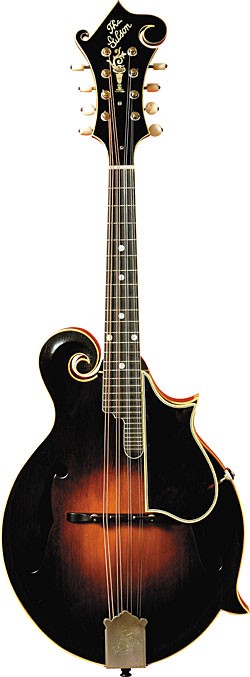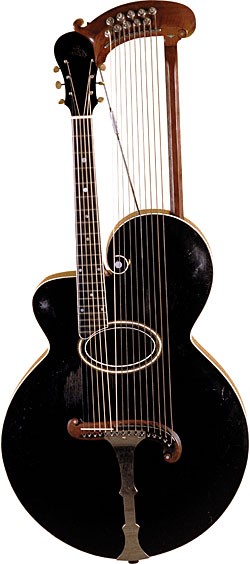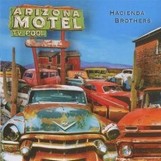
1923 Gibson F-5.
Gibson F-5 mandolins signed by Lloyd Loar from mid 1922 to 1924 are considered the Holy Grail by most American mandolin players.
Within that group of grails, however, are a few that to bluegrass aficionados are the holiest of the holy.
These F-5s have a date of July 9, 1923, and were built with “side binding” – three-ply binding oriented so the black/white/black lines are visible from the sides of the instrument, rather than from the front.
The specific date and the odd ornamentation seem to be arbitrary requirements for elevation to holiest-of-holy status, but there is a simple explanation: those are the features of Bill Monroe’s F-5, the instrument with which Monroe made his name as the “Father of Bluegrass.”
When it was introduced in 1922, the F-5 represented the perfection of the carved-top, scroll-body mandolin. As most of the mandolin world knows, the carved-top mandolin was Orville Gibson’s invention and the foundation for the Gibson company, which was organized in 1902. The company’s top model for its first 20 years was the F-4, which featured a distinctive scroll on the upper bass bout as well as scrolls on either side of the headstock. Like virtually all mandolins of that time, it had an oval soundhole.
Among the many F-4 players in the early 1900s was a graduate of Oberlin Conservatory named Lloyd Loar. He also had an interest in the science of acoustics, and in 1920 Gibson hired him to design instruments, including a new line of mandolins. Loar, who also played viola, brought the concepts of f-holes and tone-bar bracing from the violin to the new Gibson Style 5 mandolin. He also designed a longer neck (though not a longer scale), which not only gave the player more access to the higher register, it moved the bridge closer to the middle of the body. That, combined with the f-holes, gave the F-5 a markedly different sound from the F-4. Just before Loar’s models were ready for market, Gibson introduced a height-adjustable bridge and an adjustable truss rod, and these innovations were incorporated into Loar’s Style 5 Master Models. All of the Style 5 mandolin-family instruments were personally inspected by Loar and had a dated label with his signature.
Despite the F-5’s improvements, no one would have predicted that it would achieve the legendary status it has today. First of all, the mandolin era was over. Musicians who played the popular music of the ’20s had switched from mandolin to tenor banjo. Gibson’s goal in hiring Loar had been to revive interest in the mandolin, but the F-5 had about the same chance of success in the Jazz Age of the 1920s as an improved acoustic archtop would have had in the ’60s. On top of that, not all mandolin players of the ’20s shared the opinion of today’s bluegrass crowd. Julius Bellson, longtime Gibson employee and historian, said he preferred the oval hole of the Gibson F-4 to the f-holes of the F-5. Walter Kaye Bauer, who was featured in one of the earliest photos of an artist with an F-5, liked f-hole mandolins but always maintained that Loar put the f-holes in the wrong place, that they should have been smaller and much closer to the neck.
At an initial price of $200, which was raised to $250 in 1923, the F-5 was expensive compared to the $150 Martin charged for its top guitar model, the 000-45. But the F-5 was still less expensive than many professional-grade tenor banjos. Commercially, it was only a marginal success, selling about as well as could be expected in a dwindling mandolin market. And in terms of achieving the company’s goal of reviving that market, the F-5 was a complete failure. Gibson’s financial troubles continued, and after a management shakeup, Loar bailed out at the end of 1924.
In the two-and-a-half-year span in which Loar signed labels, a number of variations of the F-5 appeared, as the peghead inlay went from flowerpot to fern, metal plating went from silver to gold, and some were fitted with a Virzi Tone Producer (an internal baffle). Perhaps the oddest change occurred in mid 1923, when some were made with what appeared from a front view to be single-ply body binding. Only when the mandolin was viewed from the side were the white-black-white lines visible.
Gibson continued to offer the F-5, even though the mandolin remained deep in the shadow of the tenor banjo and, by the early 1930s, the guitar. Apparently there was enough demand for mandolins in the early 1930s to warrant a pair of new Gibsons with the scroll-body and f-holes but with the shorter neck of the F-4. One musician who found this to be a good combination of features was a young Kentuckian who played country music with his brother. By the time the Monroe Brothers made their first recordings in 1936, Bill was playing his lighting-fast mandolin runs on a Gibson F-7, one of those short-neck, f-hole models. The brothers split and Bill made a smashing debut with his own band on the Grand Ole Opry in 1939. In ’43 – coincidentally, the same year Lloyd Loar died – Monroe was on tour in Florida when he came across a used F-5 in a barber shop. The date on the label – July 9, 1923 – and the presence of unusual “side binding” would have meant nothing to him. But the sound impressed him so much he bought it for $150, which at the time was about half the price of a new F-5.
The raw power and the cutting midrange tone of Monroe’s F-5 was perfect for his music, and as he became a revered icon, his mandolin became an integral part of his artistic persona. Bluegrass mandolinists who wanted to get to the essence of Monroe’s mandolin style simply had to have a mandolin like Monroe’s. But that was never easy. Estimating from the number of known Loar-signed F-5s documented by Darryl Wolfe in his F-5 Journal, there are somewhere in the neighborhood of 300 in existence. To put this in perspective with other Holy Grail instruments, that’s more than the 91 pre-war Martin D-45s, but far less than the estimated 1,500 sunburst Les Pauls from 1958-’60.
Even though the Loar-signed F-5 became widely recognized as the best mandolin of its type ever made, not all F-5s sounded like Monroe’s. So, as mandolin players sought to get closer to Monroe, the July 9 date took on a special significance. Fortunately for those on a quest for a July 9, that was Loar’s most prolific day for signing labels, and 50 or more F-5s have that date. To get even closer to Monroe’s mandolin, a July 9 had to have “side binding” – a purely cosmetic feature found on maybe 20 percent of the July 9 mandolins (the F-5 Journal has documented 10). Even within those strict parameters, there is yet another level of hierarchy; a side-bound July 9 with a serial number closer to Monroe’s #73987 is preferable to one with a more distant serial number.
In 2005, Monroe’s side-bound July 9 sold for over $1 million. Other side-bound July 9 examples don’t bring that kind of money, of course, but they are among the most highly revered vintage fretted instruments.
This article originally appeared in VG‘s October 2007 issue. All copyrights are by the author and Vintage Guitar magazine. Unauthorized replication or use is strictly prohibited.


